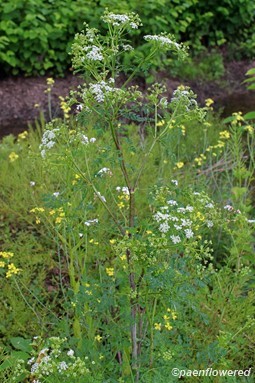Conium maculatum
Conium maculatum poison hemlock
This herbaceous species is a member of the carrot family. As its common name indicates, this is not a plant you want to include in your wild food diet. Poison hemlock is an invasive import from Europe that is now widespread throughout the North America. It blooms in late spring or early summer and now can now be seen in abundance on roadsides throughout the area.
The juices of this plant are highly poisonous and there is no specific antidote. It contains the alkaloids coniine and coniceine that cause paralysis of the respiratory system and birth defects in farm animals. The plant has been used in Eurasia as a poison for unpopular humans since ancient times. The fatal dose for an adult human is 0.1 grams of coniline, the amount contained in 6-8 leaves of this plant. The toxin is more concentrated in the seeds and roots. Humans can also get the poison through cow’s milk and by eating fowl that have fed on the plant. Conium maculatum "extract" can be purchased on the Internet in the form of bottled "globules", but it is a homeopathic medicine that is so heavily diluted that it is probably both harmless and ineffective for any medical purpose.
The poison hemlock plant is very common throughout this area. It is a large branching plant that grows on roadsides, in weedy or waste areas, in fields, or on the edges of woods. Although it tolerates poor dry soil, it can also grow in wetter and more fertile soils. Poison hemlock can grow as much as 10 feet high. It is considered a noxious weed in many states, but is not yet so listed in Pennsylvania. The dried stems are sometimes called kecksies or kex. The poison level is reduced by drying but not eliminated. Accidental cases of poisoning of humans is very rare and he only real danger is to amateur wild food foragers.
The plant has shiny dark green leaves that resemble parsley and a light grey-green, hairless, hollow, grooved stem with purple spots or streaks, especially on the bottom half of the stem. These spots and the finely divided leaves are the easiest way to distinguish this species from plants with a similar appearance. Poison hemlock has an unpleasant smell that gets worse when the plant is damaged.
The flowers are arranged in compound umbrels, each consisting of many tiny individual white flowers. Each flower is only 1/18 inches wide. The umbrel is about 2 inches in diameter, but there may be several on each stem. It is a biennial plant and only flowers the second year. It is also called poison parsley. The best control mechanism is to chop the plant down before it goes to seed. It is not toxic to touch. The introduced poison hemlock moth caterpillar also has potential for controlling the population of this plant, but I have seen little signs of success as the plant gets more abundant every year. A variety of insects obtain nectar from the flowers without suffering any harm.
Poison hemlock is not related to the evergreen Hemlock tree, but can be mistaken for other common wildflowers of the same family, some of which are not poisonous. One of these is the harmless Queen Anne’s lace (wild carrot), but this is a much smaller plant with a few dark flowers in the center of an otherwise tight, white flower cluster. Queen Anne’s lace also blooms later in the summer. Another very poisonous plant, the water hemlock (Cicuta maculata) also has a similar flower, but tends to grow in wetter places than the poison hemlock. Cow parsnip also has a similar appearance but with maple-like leaves.
Habitat & Range
Grows in roadside ditches, floodplains, and moist woods.
Present throughout the state.
| EMP: | FACW |
|---|---|
| NCNE: | FACW |
Phenology
Flowers late May to July.
Plant Codes
S-rank: No rank
G-rank: G5 (Secure)




Comments
Have you spotted this plant in your area? We'd love to hear about your experience! Share your comments or questions about the plant below. Comments are moderated before posting.